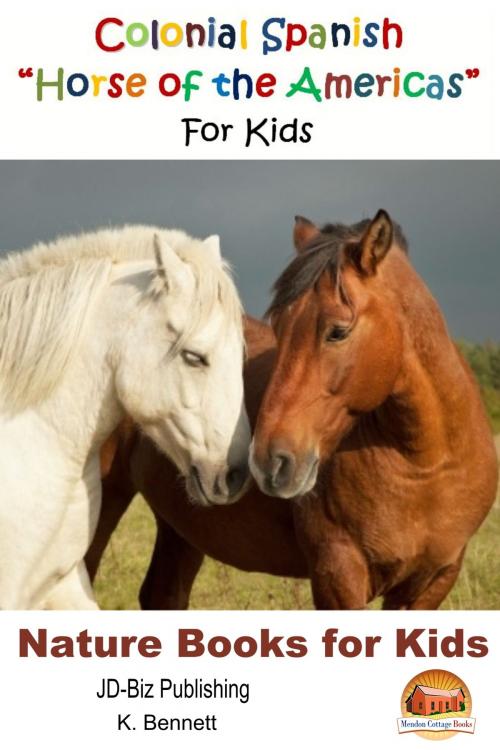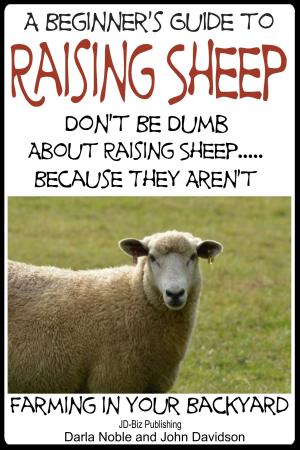| Author: | K. Bennett | ISBN: | 9781310677830 |
| Publisher: | Mendon Cottage Books | Publication: | February 23, 2015 |
| Imprint: | Smashwords Edition | Language: | English |
| Author: | K. Bennett |
| ISBN: | 9781310677830 |
| Publisher: | Mendon Cottage Books |
| Publication: | February 23, 2015 |
| Imprint: | Smashwords Edition |
| Language: | English |
Table of Contents
Introduction
Chapter 1 Great Horses
Chapter 2 Amazing Animals
Chapter 3 Horse Fun Facts!
Conclusion Nature's Amazing Wonders
Author Bio
Introduction
Feeling down? Saddle up. ~Author Unknown
***
Colonial Spanish: The Colonial Spanish horse is a very special horse. Do you know why? Because it’s more than one horse!
What does “more than one horse” mean?
The term “Colonial Spanish” is a group of horses with different names.
Names like:
*Spanish mustang
*Crillo horse
*Chilean horse
*Peruvian Paso
*Abaco Barb
*Iberian Sulphur horse
*Sulphur mustang
These horses came from Spain to the Americas and their ancestor is the Iberian horse.
The Iberian Horse
Iberian horses are native to the Iberian Peninsula. This means they come from this area.
What is a Peninsula?
The dictionary describes a Peninsula as: ‘A piece of land almost surrounded by water or “coming” out of a body of water.’ The Iberian Peninsula is on the southwest part of the European continent. If you would like to see it on a map, ask your parent or a guardian to help you search.
Colonial Spanish Horse
These beautiful horses have an old history. Before they were known as Colonial Spanish horses, they were called “Jennet or Spanish Barb.” There are just a few unique Colonial Spanish horses left, so this breed is in danger of extinction.
How big are they?
The size can be large or small. Some are between 13 – 14.2 hands and some stand at 15 hands or more.
Where do Colonial Spanish horses come from?
These beautiful horses came to the New World (Americas) with the Spanish explorers many years ago. Then they started to grow and multiply and soon they spread all over the country.
The website Livestockconservancy.org notes: “Spanish horses were the most common type of horse throughout the Southeast and all of the regions west of the Mississippi.”
That means at one time, these horses were the most common type of horse you could find!
Table of Contents
Introduction
Chapter 1 Great Horses
Chapter 2 Amazing Animals
Chapter 3 Horse Fun Facts!
Conclusion Nature's Amazing Wonders
Author Bio
Introduction
Feeling down? Saddle up. ~Author Unknown
***
Colonial Spanish: The Colonial Spanish horse is a very special horse. Do you know why? Because it’s more than one horse!
What does “more than one horse” mean?
The term “Colonial Spanish” is a group of horses with different names.
Names like:
*Spanish mustang
*Crillo horse
*Chilean horse
*Peruvian Paso
*Abaco Barb
*Iberian Sulphur horse
*Sulphur mustang
These horses came from Spain to the Americas and their ancestor is the Iberian horse.
The Iberian Horse
Iberian horses are native to the Iberian Peninsula. This means they come from this area.
What is a Peninsula?
The dictionary describes a Peninsula as: ‘A piece of land almost surrounded by water or “coming” out of a body of water.’ The Iberian Peninsula is on the southwest part of the European continent. If you would like to see it on a map, ask your parent or a guardian to help you search.
Colonial Spanish Horse
These beautiful horses have an old history. Before they were known as Colonial Spanish horses, they were called “Jennet or Spanish Barb.” There are just a few unique Colonial Spanish horses left, so this breed is in danger of extinction.
How big are they?
The size can be large or small. Some are between 13 – 14.2 hands and some stand at 15 hands or more.
Where do Colonial Spanish horses come from?
These beautiful horses came to the New World (Americas) with the Spanish explorers many years ago. Then they started to grow and multiply and soon they spread all over the country.
The website Livestockconservancy.org notes: “Spanish horses were the most common type of horse throughout the Southeast and all of the regions west of the Mississippi.”
That means at one time, these horses were the most common type of horse you could find!















